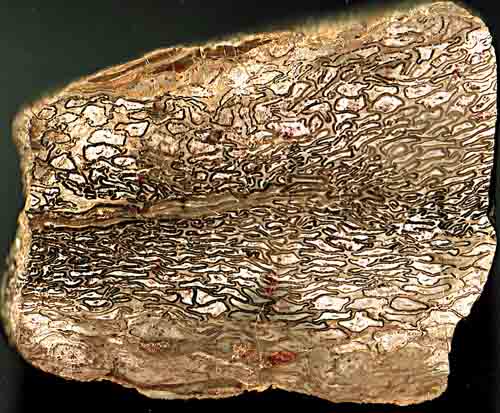Permian cherts
Fossils
preserved in chert are less well known even to people interested in
palaeontology. As an exception, the
famous Rhynie chert fossils
(Lower Devonian, Scotland)
are pictured in every palaeontology monograph but
are seldom seen as real samples. Fossiliferous Permian
cherts can be found at
several sites worldwide but have attracted less attention during 20th
century. In early 19th century, however, a few pieces of Lower Permain
chert
called "maggot stones" contributed greatly to the rising interest in
fossils and their interpretation. The "Permian Chert News" part of this
website is meant to contribute to the renewed interest in the cherts
from
the classic "maggot stone" location and
elsewhere as there are good reasons to assume that they will reveal
lots of newsworthy facts.

For
example, there are cross-sections of fern pinnules in chert samples
from Sardinia (Fig.1) which look perfectly like those of the "maggot
fern" from cherts of the Döhlen basin, Germany, while some other plant
parts in the cherts from the two locations look much different.
Observations of this kind contribute to the fascination
emanating from fossiliferous cherts.
While the big Palaeozoic ferns
are usually
known as two separately fossilized parts: the beautifully silicified
trunks often shown as polished round cross-sections, and the often less
well preserved compressed fronds on siltstone slabs, preservation in
chert is different. Here, the parts can be found lying
together
and preserved within their habitat,
a shallow swamp turned into chert by silicification. As a peculiar
fact, the state of preservation of trunks and fronds in chert is
usually the other way round: Trunks are more or less squeezed flat but
the foliage is not.
A chert sample with fern pinnules from Döhlen basin, first described in
19th century, serves as the type specimen of Scolecopteris
(literally: maggot fern), a genus of which more than two dozen species
are now distinguished worldwide.

Fig.1 (above): Fern pinnule cross-section with sporangia seen on the
natural smooth surface of an old chert layer fragment from
Sardinia, very similar to one of several Scolecopteris types from Döhlen basin, Saxony. Width of
the pinnule 1.7mm.
Fig.2 (left): Chert layer fragment with stem
cross-section of the tree fern Psaronius
silicified while lying in a shallow swamp in a state of partial decay.
Cut and polished, width 8cm.
It has to be mentiond that Psaronius
trunks much bigger and better preserved than
the one in Fig.2 are known from tuffaceous strata, notably from those
at Chemnitz but not from chert.
However, only preservation in chert can reveal delicate herbaceous
structures as those in Figs.1,3.
Fig.3 (below):
One of the various "unidentified lying objects" which are a common
sight in the cherts of the Döhlen basin and possibly
represent early stages of Psaronius,
collapsed but not compressed while lying in the mud. Cross-section,
width 34mm.



